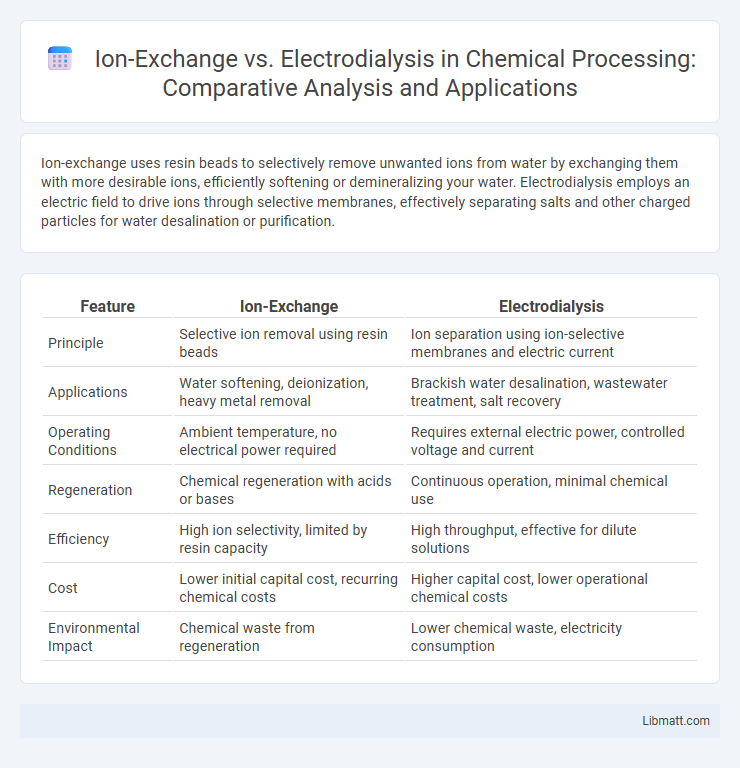Ion-exchange uses resin beads to selectively remove unwanted ions from water by exchanging them with more desirable ions, efficiently softening or demineralizing your water. Electrodialysis employs an electric field to drive ions through selective membranes, effectively separating salts and other charged particles for water desalination or purification.
Table of Comparison
| Feature | Ion-Exchange | Electrodialysis |
|---|---|---|
| Principle | Selective ion removal using resin beads | Ion separation using ion-selective membranes and electric current |
| Applications | Water softening, deionization, heavy metal removal | Brackish water desalination, wastewater treatment, salt recovery |
| Operating Conditions | Ambient temperature, no electrical power required | Requires external electric power, controlled voltage and current |
| Regeneration | Chemical regeneration with acids or bases | Continuous operation, minimal chemical use |
| Efficiency | High ion selectivity, limited by resin capacity | High throughput, effective for dilute solutions |
| Cost | Lower initial capital cost, recurring chemical costs | Higher capital cost, lower operational chemical costs |
| Environmental Impact | Chemical waste from regeneration | Lower chemical waste, electricity consumption |
Introduction to Ion-Exchange and Electrodialysis
Ion-exchange and electrodialysis are advanced water treatment technologies designed to remove ions from liquid solutions efficiently. Ion-exchange utilizes resin beads to selectively replace undesirable ions with more benign ones, making it ideal for softening hard water or removing heavy metals. Electrodialysis employs electrically charged membranes that separate ions under an electric field, offering precise control for desalination and wastewater treatment in industrial and municipal applications.
Principles of Ion-Exchange Technology
Ion-exchange technology operates by exchanging ions between a solution and a solid resin with charged functional groups, effectively removing unwanted ions from water or other liquids. This process relies on chemical affinity and selectivity, where ion-exchange resins capture specific ions and release others to maintain charge balance. Understanding these principles helps optimize your water treatment system by selecting the appropriate resin type for targeted contaminants.
Fundamentals of Electrodialysis Process
Electrodialysis utilizes ion-exchange membranes and an electric potential to selectively separate ions from saltwater or wastewater, facilitating desalination or deionization. Ion-exchange membranes allow either cations or anions to pass while blocking others, creating concentrated and diluted streams through ion migration driven by the electric field. Your understanding of this process is essential for optimizing electrodialysis performance in applications such as water purification and industrial electrolyte recovery.
Key Differences in Mechanisms
Ion-exchange involves the selective substitution of ions between a solution and a solid resin, enabling targeted removal or recovery of specific ions based on charge and affinity. Electrodialysis utilizes an electric potential to drive ions through selective membranes, separating ions based on charge by migration toward oppositely charged electrodes. Your choice between these methods depends on factors like ion concentration, selectivity requirements, and energy consumption.
Efficiency and Performance Comparison
Ion-exchange systems provide high selectivity and capacity for removing specific ions, making them efficient for targeted water purification and industrial chemical processing. Electrodialysis offers superior energy efficiency by utilizing electric potential to separate ions, performing well in desalination and wastewater treatment with continuous operation and lower chemical usage. Performance comparison highlights ion-exchange excels in ion specificity and regeneration capability, whereas electrodialysis is favored for scalability, operational cost-effectiveness, and environmental sustainability in large-scale applications.
Applications in Water Treatment and Purification
Ion-exchange processes excel in removing specific ions such as heavy metals, hardness, and nitrates from water, making them ideal for potable water softening and industrial wastewater treatment. Electrodialysis efficiently separates salts and charged contaminants from brackish water and desalination brine by applying an electric potential across selective membranes, enabling cost-effective desalination and seawater treatment. Your choice between ion-exchange and electrodialysis depends on the targeted contaminants and operational scale within water treatment and purification systems.
Advantages and Limitations of Ion-Exchange
Ion-exchange offers high selectivity and efficiency in removing specific ions from water, making it ideal for applications like softening and demineralization. Its advantages include cost-effectiveness in operation and the ability to regenerate resins for repeated use, which ensures sustainability. Limitations involve sensitivity to fouling, limited capacity for large-scale treatment, and potential chemical use for regeneration affecting overall environmental impact.
Pros and Cons of Electrodialysis
Electrodialysis offers efficient desalination with lower energy consumption compared to traditional ion-exchange methods, especially for brackish water treatment. It provides selective ion removal, reducing chemical usage and minimizing waste sludge production, but its initial setup cost can be high and membranes may require frequent maintenance. Your choice depends on water quality, operational budget, and environmental considerations.
Cost Analysis: Ion-Exchange vs Electrodialysis
Ion-exchange systems generally have lower upfront costs but higher operational expenses due to frequent resin replacement and chemical regeneration requirements. Electrodialysis involves a higher initial investment for membrane stacks and power supply but offers reduced ongoing chemical usage and energy-efficient ion removal. Your choice depends on weighing short-term budget constraints against long-term operational savings and process scalability.
Choosing the Right Method: Factors to Consider
Choosing between ion-exchange and electrodialysis depends on factors such as the ionic composition of your water, treatment capacity, and operational costs. Ion-exchange excels in removing specific ions like hardness-causing calcium and magnesium, while electrodialysis is more efficient for desalination and selective ion removal in large volumes. Your decision should consider water quality goals, maintenance requirements, and energy consumption to optimize treatment performance and cost-effectiveness.
Ion-exchange vs electrodialysis Infographic

 libmatt.com
libmatt.com